
VDOE Anatomy and Physiology Content GuidelinesThese guidelines are intended to become Standards of Learning during the next science revision.
- Subject:
- Science
- Material Type:
- Unit of Study
- Author:
- Anne Petersen
- Date Added:
- 09/16/2020

VDOE Anatomy and Physiology Content GuidelinesThese guidelines are intended to become Standards of Learning during the next science revision.

A labeled diagram of a Resource Landing Page, identifying the various elements.
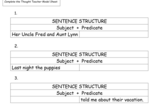
This is a follow-up lesson after the students understand a complete sentence and its parts (subject and predicate). Students will add missing subjects or predicates to make complete sentences. Students will begin the sentences with capital letters and end them with punctuation marks. This mini-lesson follows the "I DO, WE DO, YOU DO" approach.
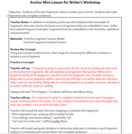
Students will locate fragments and correct fragments within a written piece of text.
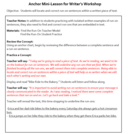
Students will read, locate, and correct run-on sentences within a written piece of text. In addition to students practicing with isolated written examples of run-on sentences, they also need to find and correct run-ons that are embedded in text. This lesson will allow students to practice this skill.
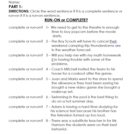
This is an introductory lesson. Students will identify and correct run-on sentences.
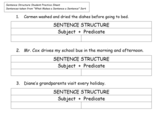
Through questioning, students will recognize the subject and predicate parts of a sentence-Who or What is the sentence about? What is the subject doing? Students will separate sentences into their subject and predicate parts.
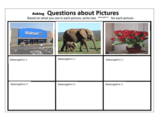
Students will use and punctuate declarative, imperative, interrogative, and exclamatory sentences about a picture. This lesson will give students the opportunity to vary sentence types in their own writing.
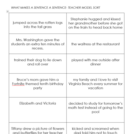
This is an introductory lesson in which students will learn to distinguish between a complete sentence and a fragment by determining if there is a subject and predicate. Students will identify and sort as complete or fragment. This lesson follows the "I Do, We Do, You Do" approach.

In this unit culminating project, students get to choose an ancient civilization to research and share with others. First, they use maps to identify where their chosen civilization was located at the beginning of their culture, during their period of greatest influence, and where it is located today. Students then use Scratch programming to create an interactive program that includes sequences, loops, and events to show information about their chosen civilization. Finally, they share their program with others and reflect on their learning.
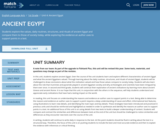
In this unit, students explore ancient Egypt. Over the course of the unit students learn and explore different characteristics of ancient Egypt and what the ancient Egyptians valued. Through learning about the daily routines, structures, and rituals of ancient Egypt, students will be challenged to draw conclusions about what the civilization valued and how those values compare to society today. Students will also learn about the role that mummies and pyramids played in ancient Egyptian society and why archeologists and scientists have been intrigued by them ever since. In second and third grade, students will continue their exploration of ancient civilizations by learning more about ancient Greece and ancient Rome. It is our hope that this unit, in conjunction with the others in the sequence, will help students understand and appreciate early civilizations that have had a lasting impact on the world.
In reading, this unit focuses on understanding the reasons and evidence an author uses to support points in a text. Being able to determine the reasons and evidence an author uses to support a point requires a deep understanding of cause and effect, informational text features, using illustrations to learn new details, and identifying the main topic and key details. These strategies have been introduced and practiced in previous units and should be reinforced and highlighted as needed in order to synthesize and identify the reasons an author uses to support points in a text. An additional focus of this unit is on using details from two texts to build a deeper understanding of content. Students will compare and contrast the similarities and differences between texts at the end of the unit but should be challenged to notice similarities and differences as they encounter new texts over the course of the unit.
In writing, students will continue to write daily in response to the text. At this point students should be fluid in writing about the text in a structured way. Therefore, the focus of this unit is on pushing students to include the best and most accurate evidence and then to explain the evidence with inferences or critical thinking.

This inquiry focuses on the impact of the flooding of the Nile River on ancient Egypt, specifically the costs and benefits of the flooding. Through examination and analysis of various photographs, videos, and article excerpts, students will consider how these sources can be used to convey the impact of flooding on multiple groups of people in ancient Egypt.The questions, tasks, and sources in this inquiry asks students to learn about how Egyptian civilization grew by comparing the costs and benefits of the Nile River’s flooding. This inquiry highlights the following Virginia social studies standards.

In the second lesson of four on Ancient Greece, students refine their knowledge of physical features as they investigate pictures of Greece and determine how a particular physical feature influenced human action. Key question: How did the physical geography of the Aegean basin shape the economic, social and political development of Greek civilization?

This inquiry focuses on the government of Ancient Greece, specifically the creation of the Greek democracy. The questions, tasks, and sources in this inquiry asks students to consider the meaning of democracy and whose voices were heard in the original democracy and whose were not. Through analysis of videos, photographs of ancient artifacts, political cartoons and graphs students develop an argument supported by evidence that answers the compelling question, “Was Greek democracy a success?”

In the first lesson of four on Ancient Greece, students use geographic terms such as hemispheres, continents, and direction to describe the relative location of Greece within the world, within Europe, and within the Aegean Basin. In addition, students extend and refine their ability to identify various types of physical features on maps at a variety of scales. Students examine maps to identify and describe the physical environment of Greece. Key questions: Where is ancient Greece located?; What are physical features of the Aegean Basin?; How did the location of Greece and its physical environment influence its interaction with the rest of the world?

In the third lesson of four on Ancient Greece, students simulate trade between Greek city states and their colonies. The overall goal is for the Greek traders and colonists to travel to new territories, trade resources, and as a result build an empire and spread Hellenistic culture. Through the examination of the goods exchanged, students gain a basic understanding of specialization in the various areas of the Mediterranean Basin. Key questions: Why did the Greeks acquire colonies?; How did Greek culture diffuse throughout the Mediterranean world?; What were the effects of the diffusion of Greek culture?

In the last lesson of four on Ancient Greece, students employ spatial thinking to understand the extent of the empire of Alexander the Great by examining and comparing visuals and maps. Key question: How does the geographic extent of an empire influence its ability to exist through time?

In the first of two lessons on ancient river valley civilization, students examine the physical environment of the early river valley civilizations. After identifying the locations of the ancient civilizations, students complete a feature analysis to assist them in comparing the physical environments and determining how it afforded protection to the civilizations. Key questions: Why was a river valley a good place for a settlement? What was the significance of these river valley civilizations?

In the second of two lessons on ancient river valley civilizations, students examine the physical environment of the early river valley civilizations. Moving water carries and sorts sediment, changes landforms, and creates strata. The sediment becomes the base for soil formation, and it is the material of which flood plains, deltas, and natural levees are built. Through a demonstration of the sedimentation process, students will come to understand the significance of the process and seasonal flooding to agricultural activity in the early river valley civilizations. Key questions: How does the process of sedimentation affect soil fertility? Why are some river valleys good sites for human settlement?
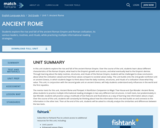
In this unit students explore the rise and fall of the ancient Roman Empire. Over the course of the unit, students learn about different characteristics of the Roman Empire, what lead to the Empire's growth and success, and what eventually lead to the Empire's demise. Through learning about the daily routines, structures, and rituals of the Roman Empire, students will be challenged to draw conclusions about what the civilization valued and how those values compare to societal values today. This unit builds onto the 2nd grade nonfiction unit on ancient Greece, in which students began to think about how the daily routines, structures, and rituals of a civilization show what they value. This unit, in conjunction with the second grade unit on ancient Greece, will help students understand early influences in the world and the first republics.
The mentor texts for this unit, Ancient Rome and Pompeii: A Nonfiction Companion to Magic Tree House and Eye Wonder: Ancient Rome, allow students to practice multiple informational reading strategies in two very different text structures. In both texts, but predominately in Eye Wonder, students will practice using a multitude of text features and illustrations as a way of learning new information about a topic. Over the course of this unit, students will constantly be thinking about how the information from one text builds on and connects to the information in the other text. Then at the end of the unit, students will be asked to critically analyze the similarities and differences between the two texts.